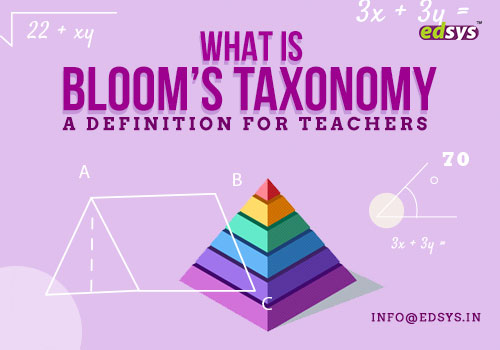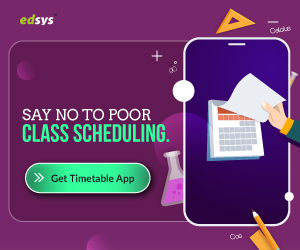Categories(658 Blogs)
Select Category
Watch Right Now
Teacher App - Class
Schedule & Attendance Management App
Parent App from Edsys

Best School Bus Tracking System

Cashless School - For Smart Schools of Tomorrow


What is Blooms Taxonomy? A Definition for Teachers

In 1956, Benjamin Bloom created Blooms Taxonomy. Since then, it is regarded as a comprehensive platform where the learning objectives and its outcomes are classified in a systematic way. This model is used effectively for teaching and learning purposes.
Blooms Taxonomy can be defined as a methodical classification of cognitive skills (as educational learning objectives) to help teachers teach and assess student capabilities better while helping students study well.
The reason for developing Blooms Taxonomy was to provide teachers a common language to converse and exchange learning and evaluation techniques. The ultimate goal of a teacher who uses Blooms taxonomy will be to promote higher-order thought among the learners by pushing up from lower-order cognitive skills.
Levels of Blooms Taxonomy
In a typical classroom setting, educators can apply the principles from different levels of taxonomy to get the best out of the possibilities of intellectual learning. Let’s have a look into the different levels of blooms taxonomy and the way teachers use it in a cognitive domain.
Knowledge (Remember): This is the bottom-most but highly relevant level in Blooms taxonomy. The level involves identifying or recalling facts, basic concepts, terms, or answers without essentially being aware of exactly what they mean. The characteristics may include terminology, specific facts, trends and sequences, principles and generalizations.
Example: Name four common Banana varieties
Comprehension (Understand): This level of Blooms taxonomy is in fact progression from the previous stage (Knowledge) in which information can be interpreted with more readiness. This stage is more about identifying the differences and similarities while making comparisons.
Example: Identify the distinguishing features of a Manzano banana in comparison with a Cavendish banana.
Application: The third but one of the important levels of Blooms Taxonomy is Application which needs a different sort of thinking from the learners. This stage demands learners to make use of the pre-learned information in a somewhat diverse way. This stage will be a success if they can apply the learning in a diverse range of novel circumstances and yield the expected outcome.
Example: Would bananas prevent cardiovascular disease and digestive problems?
Analysis: This is a key stage where learners have to fall back on what they learned in the first stage of blooms taxonomy and retrieve user information. The information in the repository needs to be broken down after having a deeper look at it. The characteristics include analysis of elements, relationships and organization.
Example: List three ways of preparing foods with bananas and provide details about which cuisine can have the best health benefits. Give references to justify your statements.
Synthesis: This stage is about using the information to go an extra step in the progression. This is to insist learners bring in some initiatives and apply novel ideas as a means to problem-solving. This stage demands good planning through which broken pieces of information are put together to get the best results.
Example: Alter an “unhealthy” recipe for the banana cream pie to a “healthy” one by swapping your pick of ingredients. Clarify the health benefits of the newly added ingredients vs. the original ones.
Also Read: 24 Best Classroom rules that will improve student’s behavior
Evaluation: The final phase of Blooms taxonomy is the evaluation of all the learning you had. This involves considering different people’s ideas, criticizing them and at the same time evaluating your personal perspectives.
Example: Which types of bananas are best for baking a banana cream pie, and why?
Creation: This level was added in the revised taxonomy that came out in 2001. It involves coming up with the solution for old problems by addressing the flaws or failures of the previous case.
What makes Blooms finding really special is the way it helps teachers to reflect their teaching and importantly on the consequent learning and understanding of the students. In addition, it could be applied to nearly everything in a learning scenario.
Teaching Strategies with Bloom’s Taxonomy
Blooms Taxonomy is a really influential tool to renovate the phases of teaching and learning. Teachers have to be well planned about how to make use of the possibilities of Blooms taxonomy to build strategies for the classroom. Unlike the basic instructions and content, this is more about the focus to cognitive events in the student’s mind.
Let us see some key teaching strategies that can be used in today’s classroom to get the best outcome of Blooms taxonomy.
- Make Use of all Levels: There is a common misunderstanding that the bottom level that relates to memorization is given more importance than it deserves. However, the reality is that each of the level has its own significance and utilizing all of them through progression is the key.
In fact, memorization can minimize the cognitive load and they can easily progress to the next levels through quick recall and application.
- Utilize Blooms Spiraling: This means to spend considerable time at each level before moving to the next level to get the exact benefit of real progression. This helps students to cope up with the demand for an increased level of thinking. This, in turn, helps to use it as an ultimate trail to lead the learning process.
- Using Technology to Highlight Particular Levels: In Blooms revised taxonomy, the emphasis is shifted towards creativity and this demands students to think more innovatively.
Utilizing the possibilities of social media and digital technology can be a great approach in this context. It gives students a platform to learn at their own pace by bringing in a lot of thinking. They can simply observe and put in strategic input by taking into account their background knowledge, readiness, and relevant expertise.
- Allowing Students to Lead: Giving students a chance to bring in their own thinking and ideas to the structure can make a lot of difference in the way they progress.
The resultant collection of information can be presented in a classroom showcase or student community to acknowledge the effort they have put in.
- Plan Project-Related Learning Sequences: This can be a groundbreaking change in the way a student progresses in his learning. However, it is not something out of the box as anyone might think.
- The initial level is defining, recalling and identifying key modules of a project and its challenges.
- The second stage is evaluating the cause or effect of the modules and challenges.
- The final stage enables them to formulate new strategies to solve the challenges and improve the situation.
- Give credits for each level: It is important to give equal points or credits for students being involved in all levels as each level has its own significance. However, you can reduce points if it seems students are spending a longer time than expected at lower levels.
Applying Bloom’s Taxonomy in the Classroom
Blooms Taxonomy is an influential platform for learning and teaching that lets you shape almost anything that is part of your classroom. Here let us have a look at the number of ways a teacher can use this platform.
- Design or enhance an assessment
- Offer learning feedback
- Visualize progress of student over the course
- Direct research projects
- Develop question stems
- Differentiate instruction
- Learning reflection journals
- Frame a mini-lesson
- Summarize a reading passage
- Refine and enhance queries
- Map curriculum
- Assess the champ in a debate
- Assist students to develop reading response prompts
- Brainstorm ideas for project-based learning
These are a few among the thousands of ideas which show the power of Blooms Taxonomy. A wise teacher can make the best out of this comprehensive theory and cultivate highly valued qualities in his or her students.
Conclusion
Developing learning objectives is the key goal of using Blooms Taxonomy. It is explained in a simple way by telling how remembering a concept is the key before understanding it and how understanding it is the key before you can apply it.
Similarly, a thorough analysis is necessary before you can initiate an evaluation process and how a thorough evaluation is critical before you create an accurate conclusion.
The taxonomy from Benjamin was purely one-dimensional and the ultimate focus was particularly on the knowledge domain but it was way ahead of the time. The updated version sees it from a different angle that gives more significance to the powerful combo of knowledge content and cognitive processes.
Recent Blogs
Our Educational Services
Popular Blogs
Subscribe

SUBSCRIBE TO OUR NEWSLETTER
Sign Up and Recieve the Latest News
Don’t Worry, We Don’t SpamExplore Our Extensive Researched Educational App Directory
Visit Now
















